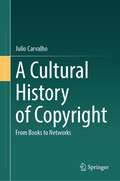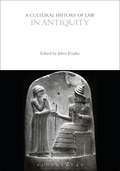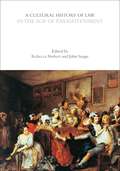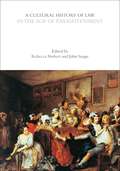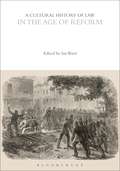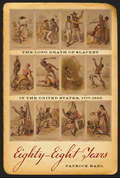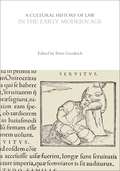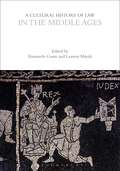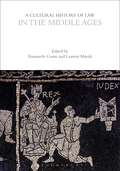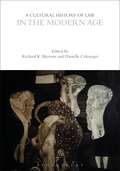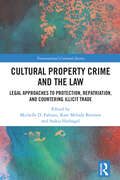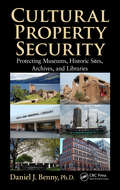- Table View
- List View
Cultural Heritage, Sustainable Development and Human Rights: Towards an Integrated Approach (Routledge Studies in Cultural Heritage and International Law)
by Laura PineschiThe importance of cultural heritage - in both its tangible and intangible forms - to sustainable development and its economic, social and environmental components is increasingly evident in the recent practice of intergovernmental and non-governmental organizations at the universal and regional level. Due consideration for the integration of the cultural dimension in the implementation of Agenda 2030 has begun to grow in various international fora, including initiatives to emphasize the role and contribution of tangible and intangible heritage as drivers and enablers of sustainable development. It has also been recognized that the inherent links between cultural heritage and sustainable development cannot be correctly addressed without taking into account their various implications for the effective enjoyment of all human rights, including cultural rights. This book offers a thorough academic investigation on the importance of cultural heritage to sustainable development and cultural rights from an international law perspective. Providing an in-depth review of the possible intersections between cultural heritage, sustainable development and cultural rights and the limits of the current legal and institutional framework, it will be of interest to researchers and scholars of international law, cultural heritage law, environmental law and human rights law.
Cultural Heritage, Sustainable Development and Human Rights: Towards an Integrated Approach (Routledge Studies in Cultural Heritage and International Law)
by Laura PineschiThe importance of cultural heritage - in both its tangible and intangible forms - to sustainable development and its economic, social and environmental components is increasingly evident in the recent practice of intergovernmental and non-governmental organizations at the universal and regional level. Due consideration for the integration of the cultural dimension in the implementation of Agenda 2030 has begun to grow in various international fora, including initiatives to emphasize the role and contribution of tangible and intangible heritage as drivers and enablers of sustainable development. It has also been recognized that the inherent links between cultural heritage and sustainable development cannot be correctly addressed without taking into account their various implications for the effective enjoyment of all human rights, including cultural rights. This book offers a thorough academic investigation on the importance of cultural heritage to sustainable development and cultural rights from an international law perspective. Providing an in-depth review of the possible intersections between cultural heritage, sustainable development and cultural rights and the limits of the current legal and institutional framework, it will be of interest to researchers and scholars of international law, cultural heritage law, environmental law and human rights law.
A Cultural History of Copyright: From Books to Networks
by Julio CarvalhoCombining philosophical and historical perspectives, this book focuses on the rise of a legal institution that has dominated the economy of knowledge ever since it burst onto the scene at the dawn of modernity in the heartlands of Europe. From the age of print to the age of networks and disruptive technologies, this book explores the place of copyright amid the various conceptual transformations it has undergone over time. Uniquely, it presents an in-depth philosophical treatment of the cultural history of copyright from its beginnings to the present. Although copyright is a central topic, the content is by no means limited to it. The main question the author seeks to answer is: how do legal institutions emerge and how do they evolve over time? Though copyright is a wonderful example for tackling this question, a selection of other institutions, such as the social practice of promising in eighteenth-century Britain, are also addressed at considerable length. What the author has managed to show in this book is that the transformations which modern law has undergone since the eighteenth century are inextricably linked to those which have shaped the modern subject to the core. Law forms part of those great schemes of intelligibility that allow us to understand ourselves better. We need to delve deep into the multiple layers of culture if we want to fully understand how the morphology and cultural archaeology of our legal institutions intertwine.
A Cultural History of Law in Antiquity (The Cultural Histories Series)
by Julen EtxabeHow should we talk about “the law” in a period so remote from our own and covering such a huge span of time and space? From the Code of Hammurabi (ca. 1750 BCE) to Justinian's Corpus Iuris Civilis (529-534 CE), A Cultural History of Law in Antiquity draws upon legal texts and non-textual forms (such as vase-painting, sculpture, and architecture) to uncover the diverse and rich legal traditions of societies ranging from the Ancient Near Eastern cities of Assyria and Babylon in Mesopotamia to the Ancient Israelites, and from Ancient Greece to Rome of the Archaic and Classical Periods.With a wealth of textual and visual sources, A Cultural History of Law in Antiquity presents essays that examine key cultural case studies of the period on the themes of justice, constitution, codes, agreements, arguments, property and possession, wrongs, and the legal profession.
A Cultural History of Law in Antiquity (The Cultural Histories Series)
by Julen EtxabeHow should we talk about “the law” in a period so remote from our own and covering such a huge span of time and space? From the Code of Hammurabi (ca. 1750 BCE) to Justinian's Corpus Iuris Civilis (529-534 CE), A Cultural History of Law in Antiquity draws upon legal texts and non-textual forms (such as vase-painting, sculpture, and architecture) to uncover the diverse and rich legal traditions of societies ranging from the Ancient Near Eastern cities of Assyria and Babylon in Mesopotamia to the Ancient Israelites, and from Ancient Greece to Rome of the Archaic and Classical Periods.With a wealth of textual and visual sources, A Cultural History of Law in Antiquity presents essays that examine key cultural case studies of the period on the themes of justice, constitution, codes, agreements, arguments, property and possession, wrongs, and the legal profession.
A Cultural History of Law in the Age of Enlightenment (The Cultural Histories Series)
by Rebecca ProbertThe period of the Enlightenment was marked by innovation in political, cultural, religious, and educational ideas with the aim of improving the experience of human beings in society. Key to intellectual debates and day-to-day life were ideas about the law. Many looked to Britain, and to the British, as exemplars of a state governed by moderate laws under a moderate constitution. Britain's laws and constitution were portrayed and satirized in almost every artistic medium. A Cultural History of Law in the Age of Enlightenment presents essays spanning the “long 18th century” (1680 to 1820) which explore the place of law in a range of creative and artistic media, all of which flourished in a commercial society with law at its center and enlightenment as its aim.Drawing upon a wealth of visual and textual sources, A Cultural History of Law in the Age of Enlightenment presents essays that examine key cultural case studies of the period on the themes of justice, constitution, codes, agreements, arguments, property and possession, wrongs, and the legal profession.
A Cultural History of Law in the Age of Enlightenment (The Cultural Histories Series)
by Rebecca Probert and John SnapeThe period of the Enlightenment was marked by innovation in political, cultural, religious, and educational ideas with the aim of improving the experience of human beings in society. Key to intellectual debates and day-to-day life were ideas about the law. Many looked to Britain, and to the British, as exemplars of a state governed by moderate laws under a moderate constitution. Britain's laws and constitution were portrayed and satirized in almost every artistic medium. A Cultural History of Law in the Age of Enlightenment presents essays spanning the “long 18th century” (1680 to 1820) which explore the place of law in a range of creative and artistic media, all of which flourished in a commercial society with law at its center and enlightenment as its aim.Drawing upon a wealth of visual and textual sources, A Cultural History of Law in the Age of Enlightenment presents essays that examine key cultural case studies of the period on the themes of justice, constitution, codes, agreements, arguments, property and possession, wrongs, and the legal profession.
A Cultural History of Law in the Age of Reform (The Cultural Histories Series)
by Ian WardThe Age of Reform – the hundred years from 1820 to 1920 - has become synonymous with innovation and change but this period was also in many ways a deeply conservative and cautious one. With reform came reaction and revolution and this was as true of the law as it was of literature, art and technology. The age of Great Exhibitions and Great Reform Acts was also the age of newly systemized police forces, courts and prisons. A Cultural History of Law in the Age of Reform presents an overview of the period with a focus on human stories located in the crush between legal formality and social reform: the newly uniformed police, criminal mugshots, judge and jury, the shame of child labor, and the need for neighborliness in the crowded urban and increasingly industrial landscapes of Europe and the United States.Drawing upon a wealth of visual and textual sources, A Cultural History of Law in the Age of Reform presents essays that examine key cultural case studies of the period on the themes of justice, constitution, codes, agreements, arguments, property and possession, wrongs, and the legal profession.
A Cultural History of Law in the Age of Reform (The Cultural Histories Series)
by Ian WardThe Age of Reform – the hundred years from 1820 to 1920 - has become synonymous with innovation and change but this period was also in many ways a deeply conservative and cautious one. With reform came reaction and revolution and this was as true of the law as it was of literature, art and technology. The age of Great Exhibitions and Great Reform Acts was also the age of newly systemized police forces, courts and prisons. A Cultural History of Law in the Age of Reform presents an overview of the period with a focus on human stories located in the crush between legal formality and social reform: the newly uniformed police, criminal mugshots, judge and jury, the shame of child labor, and the need for neighborliness in the crowded urban and increasingly industrial landscapes of Europe and the United States.Drawing upon a wealth of visual and textual sources, A Cultural History of Law in the Age of Reform presents essays that examine key cultural case studies of the period on the themes of justice, constitution, codes, agreements, arguments, property and possession, wrongs, and the legal profession.
A Cultural History of Law in the Early Modern Age (The Cultural Histories Series)
by Peter GoodrichOpened up by the revival of Classical thought but riven by the violence of the Reformation and Counter Reformation, the terrain of Early Modern law was constantly shifting. The age of expansion saw unparalleled degrees of internal and external exploration and colonization, accompanied by the advance of science and the growing power of knowledge. A Cultural History of Law in the Early Modern Age, covering the period from 1500 to 1680, explores the war of jurisdictions and the slow and contested emergence of national legal traditions in continental Europe and in Britannia. Most particularly, the chapters examine the European quality of the Western legal traditions and seek to link the political project of Anglican common law, the mos britannicus, to its classical European language and context.Drawing upon a wealth of textual and visual sources, A Cultural History of Law in the Early Modern Age presents essays that examine key cultural case studies of the period on the themes of justice, constitution, codes, agreements, arguments, property and possession, wrongs, and the legal profession.
A Cultural History of Law in the Early Modern Age (The Cultural Histories Series)
by Peter GoodrichOpened up by the revival of Classical thought but riven by the violence of the Reformation and Counter Reformation, the terrain of Early Modern law was constantly shifting. The age of expansion saw unparalleled degrees of internal and external exploration and colonization, accompanied by the advance of science and the growing power of knowledge. A Cultural History of Law in the Early Modern Age, covering the period from 1500 to 1680, explores the war of jurisdictions and the slow and contested emergence of national legal traditions in continental Europe and in Britannia. Most particularly, the chapters examine the European quality of the Western legal traditions and seek to link the political project of Anglican common law, the mos britannicus, to its classical European language and context.Drawing upon a wealth of textual and visual sources, A Cultural History of Law in the Early Modern Age presents essays that examine key cultural case studies of the period on the themes of justice, constitution, codes, agreements, arguments, property and possession, wrongs, and the legal profession.
A Cultural History of Law in the Middle Ages (The Cultural Histories Series)
by Emanuele Conte Laurent MayaliIn 500, the legal order in Europe was structured around ancient customs, social practices and feudal values. By 1500, the effects of demographic change, new methods of farming and economic expansion had transformed the social and political landscape and had wrought radical change upon legal practices and systems throughout Western Europe. A Cultural History of Law in the Middle Ages explores this change and the rich and varied encounters between Christianity and Roman legal thought which shaped the period. Evolving from a combination of religious norms, local customs, secular legislations, and Roman jurisprudence, medieval law came to define an order that promoted new forms of individual and social representation, fostered the political renewal that heralded the transition from feudalism to the Early Modern state and contributed to the diffusion of a common legal language.Drawing upon a wealth of textual and visual sources, A Cultural History of Law in the Middle Ages presents essays that examine key cultural case studies of the period on the themes of justice, constitution, codes, agreements, arguments, property and possession, wrongs, and the legal profession.
A Cultural History of Law in the Middle Ages (The Cultural Histories Series)
by Emanuele Conte and Laurent MayaliIn 500, the legal order in Europe was structured around ancient customs, social practices and feudal values. By 1500, the effects of demographic change, new methods of farming and economic expansion had transformed the social and political landscape and had wrought radical change upon legal practices and systems throughout Western Europe. A Cultural History of Law in the Middle Ages explores this change and the rich and varied encounters between Christianity and Roman legal thought which shaped the period. Evolving from a combination of religious norms, local customs, secular legislations, and Roman jurisprudence, medieval law came to define an order that promoted new forms of individual and social representation, fostered the political renewal that heralded the transition from feudalism to the Early Modern state and contributed to the diffusion of a common legal language.Drawing upon a wealth of textual and visual sources, A Cultural History of Law in the Middle Ages presents essays that examine key cultural case studies of the period on the themes of justice, constitution, codes, agreements, arguments, property and possession, wrongs, and the legal profession.
A Cultural History of Law in the Modern Age (The Cultural Histories Series)
by Richard K. Sherwin and Danielle CelermajerThe period since the First World War has been a century distinguished by the loss of any unitary foundation for truth, ethics, and the legitimate authority of law. With the emergence of radical pluralism, law has become the site of extraordinary creativity and, on occasion, a source of rights for those historically excluded from its protection. A Cultural History of Law in the Modern Age tells stories of human struggles in the face of state authority – including Aboriginal land claims, popular resistance to corporate power, and the inter-generational ramifications of genocidal state violence. The essays address how, and with what effects, different expressive modes (ceremonial dance, live street theater, the acoustics of radio, the affective range of film, to name a few) help to construct, memorialize, and disseminate political and legal meaning.Drawing upon a wealth of visual, textual and sound sources, A Cultural History of Law in the Modern Age presents essays that examine key cultural case studies of the period on the themes of justice, constitution, codes, agreements, arguments, property and possession, wrongs, and the legal profession.
A Cultural History of Law in the Modern Age (The Cultural Histories Series)
by Richard K. Sherwin Danielle CelemajerThe period since the First World War has been a century distinguished by the loss of any unitary foundation for truth, ethics, and the legitimate authority of law. With the emergence of radical pluralism, law has become the site of extraordinary creativity and, on occasion, a source of rights for those historically excluded from its protection. A Cultural History of Law in the Modern Age tells stories of human struggles in the face of state authority – including Aboriginal land claims, popular resistance to corporate power, and the inter-generational ramifications of genocidal state violence. The essays address how, and with what effects, different expressive modes (ceremonial dance, live street theater, the acoustics of radio, the affective range of film, to name a few) help to construct, memorialize, and disseminate political and legal meaning.Drawing upon a wealth of visual, textual and sound sources, A Cultural History of Law in the Modern Age presents essays that examine key cultural case studies of the period on the themes of justice, constitution, codes, agreements, arguments, property and possession, wrongs, and the legal profession.
Cultural Legal Studies: Law's Popular Cultures and the Metamorphosis of Law
by Cassandra Sharp Marett LeiboffWhat can law’s popular cultures do for law, as a constitutive and interrogative critical practice? This collection explores such a question through the lens of the ‘cultural legal studies’ movement, which proffers a new encounter with the ‘cultural turn’ in law and legal theory. Moving beyond the ‘law ands’ (literature, humanities, culture, film, visual and aesthetics) on which it is based, this book demonstrates how the techniques and practices of cultural legal studies can be used to metamorphose law and the legalities that underpin its popular imaginary. By drawing on three different modes of cultural legal studies – storytelling, technology and jurisprudence – the collection showcases the intersectional practices of cultural legal studies, and law in its popular cultural mode. The contributors to the collection deploy differentiated modes of cultural legal studies practice, adopting diverse philosophical, disciplinary, methodological and theoretical approaches and subjects of examination. The collection draws on this mix of diversity and homogeneity to thread together its overarching theme: that we must take seriously an interrogation of law as culture and in its cultural form. That is, it does not ask how a text ‘represents’ law; but rather how the representational nature of both law and culture intersect so that the ‘juridical’ become visible in various cultural manifestations. In short, it asks: how law’s popular cultures actively effect the metamorphosis of law.
Cultural Legal Studies: Law's Popular Cultures and the Metamorphosis of Law
by Cassandra Sharp Marett LeiboffWhat can law’s popular cultures do for law, as a constitutive and interrogative critical practice? This collection explores such a question through the lens of the ‘cultural legal studies’ movement, which proffers a new encounter with the ‘cultural turn’ in law and legal theory. Moving beyond the ‘law ands’ (literature, humanities, culture, film, visual and aesthetics) on which it is based, this book demonstrates how the techniques and practices of cultural legal studies can be used to metamorphose law and the legalities that underpin its popular imaginary. By drawing on three different modes of cultural legal studies – storytelling, technology and jurisprudence – the collection showcases the intersectional practices of cultural legal studies, and law in its popular cultural mode. The contributors to the collection deploy differentiated modes of cultural legal studies practice, adopting diverse philosophical, disciplinary, methodological and theoretical approaches and subjects of examination. The collection draws on this mix of diversity and homogeneity to thread together its overarching theme: that we must take seriously an interrogation of law as culture and in its cultural form. That is, it does not ask how a text ‘represents’ law; but rather how the representational nature of both law and culture intersect so that the ‘juridical’ become visible in various cultural manifestations. In short, it asks: how law’s popular cultures actively effect the metamorphosis of law.
Cultural Objects and Reparative Justice: A Legal and Historical Analysis (Cultural Heritage Law and Policy)
by Patty GerstenblithCultural Objects and Reparative Justice provides a comprehensive legal and historical analysis surrounding a highly debated current question: Where should cultural objects that were removed without consent be located? This book follows an innovative, interdisciplinary approach based in law, history, art history, anthropology, and archaeology and proposes a paradigm for reparations. Tracing the historical foundations of the current legal framework, the work closely examines three factors that heavily informed the cultural heritage debate since the late eighteenth century: the rise of the encyclopaedic museum, the development of archaeology as a science, and the appropriation of objects in the context of armed conflict and colonialism. Each of these explorations is enriched by examples from around the globe and assessed on the international, national, and local level. Subjecting contested objects -such as the Parthenon Sculptures, those from the Yuanmingyuan Palace, the Benin artifacts, looted archaeological artefacts and human remains, and artwork stolen during the Holocaust - to this holistic approach enables a contextualisation of the unique history of appropriation of these objects. Cultural Objects and Reparative Justice outlines how current cultural heritage laws and ethical guidelines with respect to cultural heritage derive from a background of imperialism and colonialism. The book advocates for a new structure based on reparation, restitution, repatriation, compensation, and market regulation to cease perpetuating past harms and to disincentivize new ones.
Cultural Objects and Reparative Justice: A Legal and Historical Analysis (Cultural Heritage Law and Policy)
by Patty GerstenblithCultural Objects and Reparative Justice provides a comprehensive legal and historical analysis surrounding a highly debated current question: Where should cultural objects that were removed without consent be located? This book follows an innovative, interdisciplinary approach based in law, history, art history, anthropology, and archaeology and proposes a paradigm for reparations. Tracing the historical foundations of the current legal framework, the work closely examines three factors that heavily informed the cultural heritage debate since the late eighteenth century: the rise of the encyclopaedic museum, the development of archaeology as a science, and the appropriation of objects in the context of armed conflict and colonialism. Each of these explorations is enriched by examples from around the globe and assessed on the international, national, and local level. Subjecting contested objects -such as the Parthenon Sculptures, those from the Yuanmingyuan Palace, the Benin artifacts, looted archaeological artefacts and human remains, and artwork stolen during the Holocaust - to this holistic approach enables a contextualisation of the unique history of appropriation of these objects. Cultural Objects and Reparative Justice outlines how current cultural heritage laws and ethical guidelines with respect to cultural heritage derive from a background of imperialism and colonialism. The book advocates for a new structure based on reparation, restitution, repatriation, compensation, and market regulation to cease perpetuating past harms and to disincentivize new ones.
Cultural Politics and Resistance in the 21st Century: Community-Based Social Movements and Global Change in the Americas
by Edited by Kara Z. Dellacioppa and Clare WeberBy analyzing the cases present in this volume, the editors develop important steps towards a theory of social change that can adequately address the complex realities and intersectionality of identity (race, gender, class, sexuality, nationality) within and among these new movements.
Cultural Politics and the Transatlantic Divide over GMOs: Cultures Of Nature
by H. StephanAlongside other factors, cultural values and identities help to explain different regulatory frameworks for genetically modified organisms. This book uses insights from environmental history and sociology to illuminate the cultural politics of regulation in the US and the EU, with particular attention to public opinion and anti-GMO activism.
Cultural Property Crime and the Law: Legal Approaches to Protection, Repatriation, and Countering Illicit Trade (Transnational Criminal Justice)
by Michelle D. Fabiani Kate Melody Burmon Saskia HufnagelThis book explores innovative approaches to using and operating within and around both criminal law and civil law in the detection, investigation, and restitution of illicit cultural property.The volume brings together a wide range of authors who research and work in combatting cultural property crime. It explores the normative tensions and intersections between civil and criminal law and where they complement each other in the field. It focuses on innovative legal solutions to the unique challenges presented when facing a transnational form of crime that must consider varying structures of law and order, as well as a deep understanding of the heritage in question, both in past and the present cultures. The collection examines what both areas of law contribute to preventing cultural property crime from occurring, holding offenders responsible before the law, and returning objects to their rightful owners and/or places of origin. Combining the perspectives of academics and practitioners, the volume highlights voices from around the globe, using this range of experience to explore new ideas and applications of legal theory and practice to cases involving cultural property crimes.The book will be of interest to academics and practitioners in cultural property crime in the fields of criminology, law, archaeology, museum studies, political science, economics, and law enforcement.
Cultural Property Crime and the Law: Legal Approaches to Protection, Repatriation, and Countering Illicit Trade (Transnational Criminal Justice)
This book explores innovative approaches to using and operating within and around both criminal law and civil law in the detection, investigation, and restitution of illicit cultural property.The volume brings together a wide range of authors who research and work in combatting cultural property crime. It explores the normative tensions and intersections between civil and criminal law and where they complement each other in the field. It focuses on innovative legal solutions to the unique challenges presented when facing a transnational form of crime that must consider varying structures of law and order, as well as a deep understanding of the heritage in question, both in past and the present cultures. The collection examines what both areas of law contribute to preventing cultural property crime from occurring, holding offenders responsible before the law, and returning objects to their rightful owners and/or places of origin. Combining the perspectives of academics and practitioners, the volume highlights voices from around the globe, using this range of experience to explore new ideas and applications of legal theory and practice to cases involving cultural property crimes.The book will be of interest to academics and practitioners in cultural property crime in the fields of criminology, law, archaeology, museum studies, political science, economics, and law enforcement.
Cultural Property Security: Protecting Museums, Historic Sites, Archives, and Libraries
by Daniel J. BennyThe protection and security of cultural properties is of primary concern to the thousands of federal, state, county, city, and private institutions entrusted with housing and displaying our national heritage and history of our society. Cultural property security is of global importance as well, with tens of thousands of institutions internationally
Cultural Relativism in the Face of the West: The Plight of Women and Female Children
by B. BilletBillet examines the debate between the uniform application of universal human rights and cultural relativism. Billet outlines the foundations and evolution of both schools of thought. The book also examines case studies that involve either women or children and are typically viewed by the West as violations of fundamental human rights.

